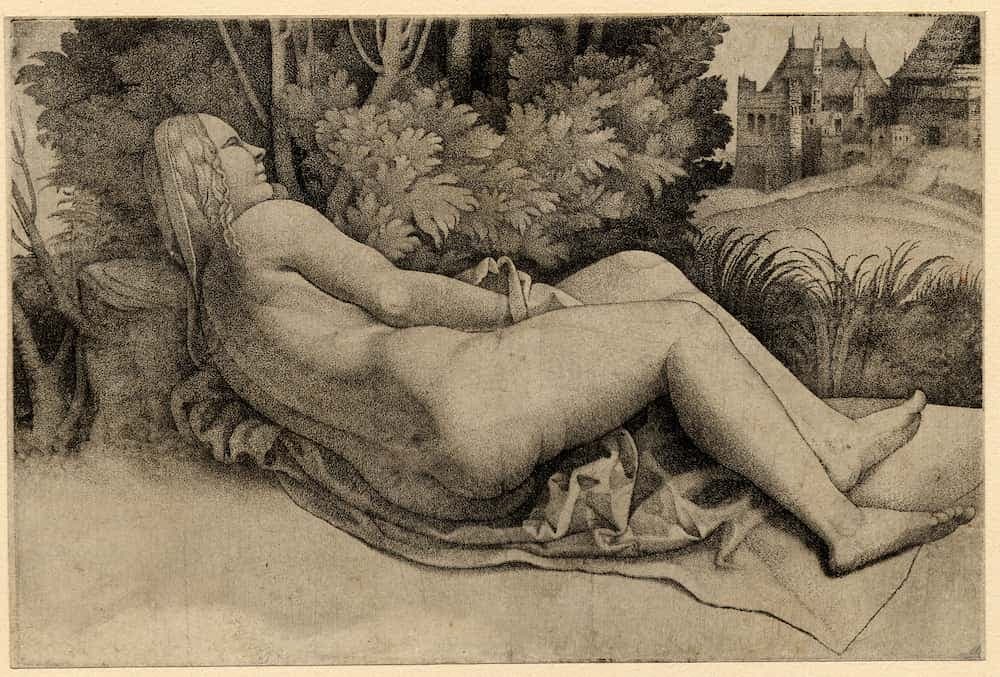- Published on
The Art and Science of Stippling in Archaeological Illustrations
- Authors

- Name
- Jona Schlegel
- @JonaSchlegel
Stippling, a precise and detail-oriented illustrative technique, has a fascinating history that dates back to the early 16th century. Its inception is frequently credited to the Italian engraver Giulio Campagnola, who pioneered this method to bring smoother tonal transitions into his artwork, a shift from the conventional techniques of hatching and cross-hatching (Accurso 2021). His efforts introduced a new level of nuance and realism in visual representation, marking a significant transformation in printmaking that later found relevance in other fields, including archaeological illustration. The legacy of Campagnola’s work, as evident in "Woman Reclining in a Landscape" (Figure 1), demonstrates the technique’s potential to add visual depth and textural subtlety, elements that have become crucial in the representation of archaeological artefacts.

Figure 1: Woman Reclining in a Landscape by Giulio Campagnola, stipple engraving, 1510–15, New York Public Library.
Archaeological illustration relies heavily on visual precision, especially for depicting artefacts' textures and subtle material details. The adaptability of stippling in black-and-white illustration made it particularly valuable, as monochromatic representations often form the core of scientific publications and field reports. Stippling conveys the intricacies of various artefact surfaces, from pottery shards to lithics, without the need for colour, using only dot density to create shadows and highlights. This technique has proven effective in illustrating the visual and textural qualities of artefacts, enhancing their academic value by adding a dimension of visual realism. Archaeologists benefit from stippling's ability to highlight the physical attributes of artefacts, aiding in interpretations related to their functionality and historical context.
Stippling's impact on archaeological illustration is profound, providing a method to convert even the most complex artefact surfaces into easily comprehensible images. The nuanced gradients of shading created through stippling have a level of three-dimensionality that is instrumental in archaeology. The physical form and surface wear of artefacts are key to understanding their cultural and technological significance, a factor that makes stippling indispensable in illustrating findings. Whether representing the rough, weathered surface of a Bronze Age axe head or the delicate curvature of ceramic shards, stippling ensures that crucial details are not lost in translation to a two-dimensional medium. By employing this technique, illustrators can accurately showcase artefacts' textures and wear patterns, contributing to the broader understanding of past human activities and material culture.

Figure 2: From left to right: Bronze axe head; Roman tile with dog print; digitally stippled Venus of Willendorf; digitally stippled frog vessel. Illustrations by Jona Schlegel.
The transition of stippling into digital illustration has also expanded its application in archaeology. As the field increasingly embraces technology, illustrators can now use digital stippling to create detailed artefact images suitable for both print and digital media. Digital tools offer the precision necessary to maintain the essence of traditional stippling while enhancing workflow efficiency. Additionally, this transition has opened new avenues for integrating 3D models into 2D formats, making artefact details accessible to a broader audience without compromising scientific accuracy (Lawonn et al., 2018). The digital format allows for more flexibility, as illustrators can adapt stippled images to various contexts, from academic publications to museum exhibitions, thus improving the dissemination of archaeological knowledge.
The stippling technique's ability to depict texture and form also highlights the importance of non-invasive and reproducible methods in archaeology. For instance, translating 3D models into 2D stippled representations provides a robust means of documentation that can be shared across different media platforms. This practice is essential for educational and research purposes, offering scholars a standardised and visually rich way to study artefacts without physically handling them, thus preserving their integrity. Moreover, stippling’s role in enhancing archaeological interpretation extends to aiding researchers in visualising the wear patterns and tool marks left on artefacts, which are often critical in understanding technological processes and cultural practices from the past (Dongyeon et al., 2008).
As part of an ongoing exploration into stippling's role in archaeological illustration, the #100DaysOfDrawingChallenge has offered an opportunity to refine and test this method. Focusing on a range of archaeological materials, this exercise has demonstrated the importance of selecting the appropriate stippling density and technique for different artefact types. Understanding when and how to apply stippling not only improves drawing skills but also contributes to a deeper comprehension of the materials themselves. Each dot placed in a stippling exercise carries the potential to transform how an artefact is interpreted and understood, making it more than just an illustrative technique; it becomes a medium for archaeological storytelling.

Figure 3: First draft of the stippling exercise by Jona Schlegel.
The stippling exercise sheet under development aims to engage both professionals and enthusiasts in the meditative and precise world of stippling. By practising this technique, one gains an appreciation of the meticulous work required to document archaeological artefacts accurately. The exercise sheet will serve as a resource for those interested in honing their illustration skills while also learning more about material culture and the best ways to represent it visually. To stay updated on these developments, subscribing to the newsletter and following the archaeoINK Instagram account are recommended.
The historical, technological, and practical facets of stippling all contribute to its enduring value in archaeological documentation. It remains a bridge between artistic skill and scientific accuracy, one that continues to evolve with advancements in digital technology while retaining its roots in the meticulous tradition set forth by early engravers. For archaeologists, stippling is not just a drawing method; it is a critical tool that shapes how artefacts are studied, shared, and remembered.
References
- Accurso, D. (2021). What is Stippling Art? [online] Available at: https://www.davidaccurso.com/blog/what-is-stippling-art [Accessed 28 March 2024].
- Dongyeon, K., Son, M., Lee, Y., Kang, H., & Lee, S. (2008). Feature‐guided image stippling. Computer Graphics Forum, 27(4), 1209–1216.
- Lawonn, K., Viola, I., Preim, B., & Isenberg, T. (2018). A survey of surface‐based illustrative rendering for visualization. Computer Graphics Forum, 37(6), 205–234.